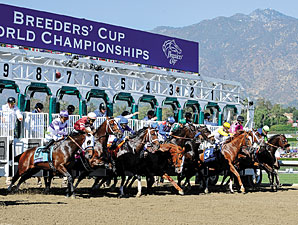Breeders' Cup: Tradition, But Not Status Quo

As the Breeders' Cup World Championships approaches its 30th edition, some things have become standard from an operations perspective, while others continue to change. As questions are answered, new ones are asked as part of an evolving process.
Bob Elliston, who took over as Breeders' Cup chief operating officer in May 2012, asked some of those questions himself during an Oct. 27 interview at Santa Anita Park, where the World Championships will be held Nov. 1-2. He noted, that despite three decades of experience, Breeders' Cup is open to change and most likely will continue to change.
"Is 14 races too many? Should the Marathon (gr. II) be something like a two-mile race for stayers on the turf? Is having 25 or 30 (horses for overseas) compete enough for us to warrant our investment? These are all questions we ask ourselves all the time," Elliston said.
Elliston said the organization's mission is to "crown champions," but he acknowledged "that's not always what we're getting." On the other hand, there are nine return winners entered in this year's Breeders' Cup races, which indicates a strong racing product that owners, breeders, and trainers support, he said.
"(Breeders' Cup) board members, breeders, and nominators ask questions all the time, and they're valid," Elliston said. "But think about it: Olympic Glory versus Wise Dan in the Mile (gr. IT), and Declaration of War facing five horses that ran in last year's Classic (gr. I). We continue to see our most compelling stories in those races.
"We want compelling stories, and if we can get that from international participation, it's worth the investment. We provide (connections) with a $40,000 travel stipend. We keep investing in it partly because the stories are compelling. If we can bring foreign horses here (it's good for the event)."
The major expansion in the number of races from eight to 14 in 2007 also made the Breeders' Cup a two-day event; the Juvenile Sprint was dropped for 2013. Seven years after the number of races was almost doubled, the move has its supporters and detractors.
In 2006 at Churchill Downs, eight Breeders' Cup races and several other races produced $140.3 million in total pari-mutuel handle on one day. Last year, with 15 Cup races and some undercard races, total handle for the two days was $148 million.
Barring some policy changes and a willingness to pay a premium for the Breeders' Cup signal by major overseas gambling markets such as Hong Kong, Elliston said increasing off-track wagering outside of the United States will be a challenge. Domestically, however, handle could rebound; officials said the impact of Hurricane Sandy on the East Coast in late October seriously dented simulcast play in 2012.
"In the simulcast market I think there is some room for growth from last year," Elliston said. "We're also trying to understand if the late post time (for the later races) causes a problem on the East Coast. Heading into the last four races Saturday last year, we thought, 'With the fields we have in these races, we'll kill it.' We actually lost ground.
"Is it because of the late post times (on the East Coast)? We don't know, so we're testing some marketing efforts (at wagering outlets in that region) this year to see if we can move the (handle) needle."
The Breeders' Cup Distaff (gr. I) Nov. 1 will be run at 4:35 p.m. PDT, or 7:35 p.m. in the Eastern time zone. The Nov. 2 Classic goes at 5:35 p.m. (8:35 p.m.), with live coverage during a one-hour prime-time broadcast on NBC.
On-track at Santa Anita, Breeders' Cup is targeting bettors who participate in its handicapping contest, which requires a $10,000 buy-in, $7,500 of which is used to wager. The number of participants will be at least 180 this year versus 137 last year; Elliston said based on previous patterns, the churn from those people alone could generate another $650,000 in on-track handle.
"One person can have a material effect (on handle)," Elliston said. "We're targeting smaller numbers that can make a difference."
As for the question of host tracks, Breeders' Cup doesn't have a defined selection policy. The event was held at Santa Anita last year, and will be held there again in 2014 for what will be a three-year run. Host sites for 2015 and beyond haven't been announced.
Elliston said there are operational advantages when Breeders' Cup is held at a host site in consecutive years: continuity in stabling, racing surfaces, local marketing, and community outreach. He indicated there is little chance of Breeders' Cup expanding beyond two days; the Thursday before and Sunday after the event are for the host track.
For instance, the organization decided that, if the Breeders' Cup Pick 6 isn't hit on Saturday, there will be a carryover to Sunday, closing day of the Santa Anita fall meet. The Thursday Breeders' Cup event party will be held at the track in part to attract participants for racing earlier in the day, Elliston said.
"We'd like to see all the folks come out and support the local venue for the Thursday card," Elliston said. "Breeders' Cup also wants to help grow their racing product. So much of what happens with the event is reliant on the host track. The capability of the management team is important to us. We have a team of 25 at Breeders' Cup, so we have to be reliant on our host track partners."
